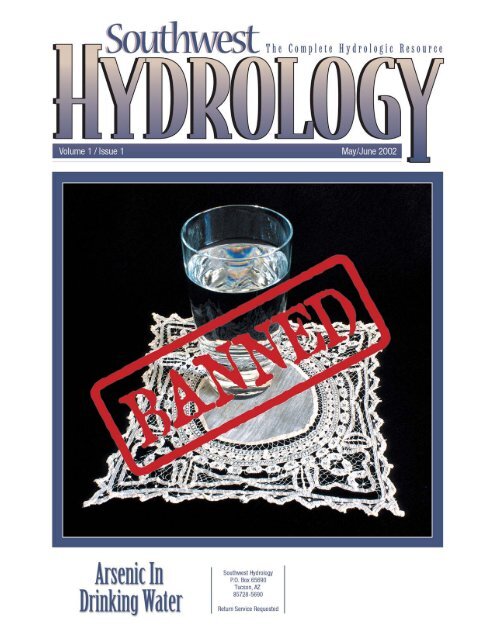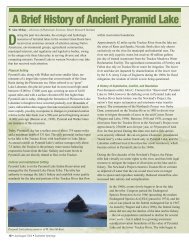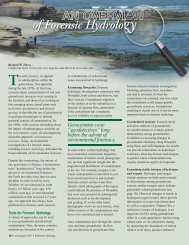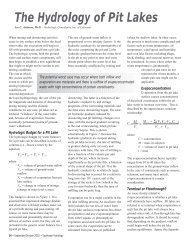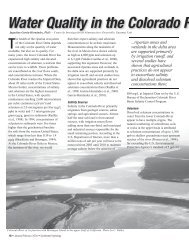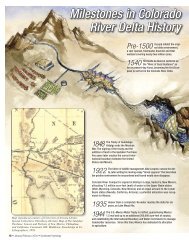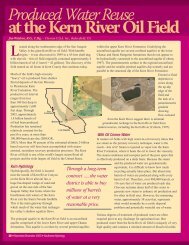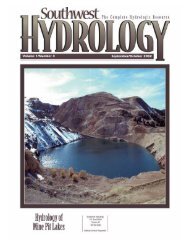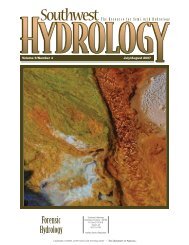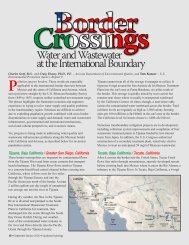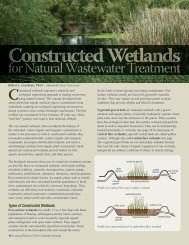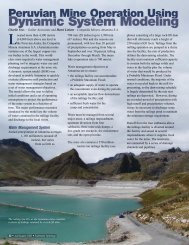Cover & Table of Contents - Southwest Hydrology
Cover & Table of Contents - Southwest Hydrology
Cover & Table of Contents - Southwest Hydrology
You also want an ePaper? Increase the reach of your titles
YUMPU automatically turns print PDFs into web optimized ePapers that Google loves.
A bimonthly trade magazine for hydrologists, water managers, and other pr<strong>of</strong>essionals working with water issues.<br />
> > > > > > > > ><br />
Inside This Issue<br />
Departments<br />
6 On the Ground<br />
New and on-going projects<br />
including water resources,<br />
cleanups, habitat restoration,<br />
monitoring programs, and more.<br />
Welcome to the premier issue <strong>of</strong> <strong>Southwest</strong> <strong>Hydrology</strong>. This magazine evolved from<br />
our hypothesis that water pr<strong>of</strong>essionals in the <strong>Southwest</strong> are interested in, and would<br />
benefit from, a forum for sharing information. We are providing the “clearing house”<br />
for receiving and distributing information about projects, research, technologies,<br />
regulations, and innovations that are unique to our semi-arid region, and you, the<br />
water community, provide that news. If you support this type <strong>of</strong> publication, please let<br />
us know by sending us your news, ideas or advertisements. As we continually grow<br />
and modify the magazine, we hope to use your input to help us develop a resource<br />
that is useful to you and your colleagues, clients, and contractors.<br />
By design, many people contributed material to this inaugural issue, and we would<br />
like to recognize and thank all <strong>of</strong> them (see “Contributors”, opposite page). The<br />
invited authors who contributed to this issue’s feature topic about the revised drinking<br />
water standard for arsenic (beginning on page 12) deserve special recognition.<br />
<strong>Southwest</strong> <strong>Hydrology</strong>’s sole financial support is advertisers. We are especially<br />
appreciative <strong>of</strong> our first-issue advertisers who supported us sight-unseen.<br />
The magazine is distributed free <strong>of</strong> charge in order to reach as many readers<br />
as possible.<br />
While <strong>Southwest</strong> <strong>Hydrology</strong> is a paper publication, our web site is up and available<br />
for posting time-sensitive announcements and job openings. In addition, the site<br />
contains information for contributors and advertisers, and links to our supporters and<br />
water-related organizations. Be sure to visit www.swhydro.com.<br />
We thank you for looking through this magazine, and look forward to<br />
your comments.<br />
Betsy Woodhouse<br />
Editor<br />
9 The State <strong>of</strong> the Nations<br />
Updates and news <strong>of</strong><br />
reservation and tribal activities.<br />
10 Government<br />
News from the legislature,<br />
agencies, and the courts.<br />
23 The Company Line<br />
What’s new in the consulting<br />
world: contracts, project<br />
announcements, personnel.<br />
24 R & D<br />
What’s happening in research,<br />
education, and technology.<br />
27 Product Announcements<br />
What’s new on the market.<br />
28 The Society Page<br />
Activities and announcements<br />
from associations, NGOs, and<br />
non-pr<strong>of</strong>it organizations.<br />
30 The Calendar<br />
Meetings, conferences, training,<br />
and short courses.<br />
4 • May/June 2002 • <strong>Southwest</strong> <strong>Hydrology</strong>
<strong>Southwest</strong> <strong>Hydrology</strong><br />
> > > > > > > > ><br />
Arsenic In Drinking Water<br />
The EPA’s reduction <strong>of</strong> the Maximum Contaminant Level for arsenic in drinking water<br />
to 10 parts per billion (ppb) has caused a storm among those charged with providing<br />
safe drinking water. System managers are faced with treating water they previously<br />
thought to be <strong>of</strong> good quality, or perhaps shutting <strong>of</strong>f wells altogether. Consultants and<br />
engineers are largely unprepared to <strong>of</strong>fer cost-effective remedial solutions to either<br />
small or large providers. Agencies are just beginning to talk about strategies to<br />
implement and monitor the strict new rule. States have not determined where the money<br />
for these changes will come from, or even if it is available. We present six articles to<br />
review the current state <strong>of</strong> affairs.<br />
12 Arsenic Removal Strategies for a<br />
New, More Stringent Standard<br />
Dr. Zaid Chowdhury, P.E.<br />
About 3,000 <strong>of</strong> the Nation’s 54,000<br />
community water systems will require<br />
some level <strong>of</strong> treatment to comply<br />
with the 10 ppb standard.<br />
14 Natural occurrence <strong>of</strong> arsenic in<br />
<strong>Southwest</strong> ground water<br />
Jon Spencer, Ph.D.<br />
Although much remains to be<br />
understood, high arsenic<br />
concentrations in groundwater are<br />
known to occur primarily in four<br />
geologic environments: lacustrine<br />
sediments, volcanic terranes,<br />
geothermal springs, and areas <strong>of</strong> goldor<br />
uranium-enriched mineralization.<br />
16 The History <strong>of</strong> Arsenic Regulation<br />
Controversy over the arsenic standard<br />
is not new. This roller-coaster ride<br />
began in 1974 with the passage <strong>of</strong> the<br />
Safe Drinking Water Act.<br />
Features in upcoming issues:<br />
17 Arsenic in Drinking Water:<br />
How Much is Too Much<br />
A. Myrick Freeman III, Ph.D.<br />
Substantial evidence exists that<br />
drinking water containing high<br />
concentrations <strong>of</strong> arsenic puts us at<br />
risk <strong>of</strong> cancer and other diseases.<br />
What is not known is whether a<br />
threshold exists, below which there is<br />
essentially no risk.<br />
18 States Move Forward to Meet New<br />
Arsenic Standard<br />
How are the States preparing for the<br />
new rule<br />
20 Assessing Arsenic Removal<br />
Technologies<br />
James Farrell, Ph.D.<br />
Several commercially-available and<br />
emerging technologies will remove<br />
arsenic from drinking water to<br />
concentrations below 10 ppb.<br />
> drought and water resources planning<br />
> tracking ancient waters<br />
> mining reclamation<br />
> watershed restoration<br />
Publisher and Editor<br />
Betsy Woodhouse, Ph.D.<br />
Publications and Business Manager<br />
Howard Grahn<br />
Features Editor<br />
Alison Bolen<br />
Graphic Design<br />
Debra Bowles/Sun People Studios<br />
Contributors<br />
Greg L. Bushner, R.G.<br />
Zaid Chowdhury, P.E.<br />
James Farrell, Ph.D.<br />
A. Myrick Freeman III, Ph.D.<br />
Jeanmarie Haney<br />
Ted Montuori<br />
Jean Moran<br />
Ray Murray<br />
Deborah Patton<br />
Gary G. Small, P.G.<br />
Jon Spencer, Ph.D.<br />
Dorothy Timian-Palmer, P.E.<br />
Jason Wen<br />
<strong>Cover</strong> Photograph by<br />
Bunkum Versatile Products<br />
Printed in the USA by Arizona Lithographers<br />
Published by Woodhouse Press, L.L.C., copyright<br />
©2002<br />
<strong>Southwest</strong> <strong>Hydrology</strong> is printed six times per year by<br />
Woodhouse Press, L.L.C. All rights reserved. Limited<br />
copies may be made for internal use only. Credit must<br />
be given to the publisher. Otherwise, no part <strong>of</strong> this<br />
publication may be reproduced without prior written<br />
permission <strong>of</strong> the publisher.<br />
Subscriptions<br />
Subscriptions to <strong>Southwest</strong> <strong>Hydrology</strong> are available<br />
free <strong>of</strong> charge. Send subscription requests and<br />
inquiries to <strong>Southwest</strong> <strong>Hydrology</strong>, PO Box 65690,<br />
Tucson, AZ 85728; or send email to<br />
mail@swhydro.com. To subscribe via the Web, go to<br />
www.swhydro.com.<br />
Advertising<br />
<strong>Southwest</strong> <strong>Hydrology</strong> is financed solely through<br />
advertising. Direct ad inquiries to <strong>Southwest</strong><br />
<strong>Hydrology</strong>, PO Box 65690, Tucson, AZ 85728; send<br />
email to mail@swhydro.com; call toll-free 866.615-<br />
2144. Rates are available at www.swhydro.com.<br />
Letters and Other Inquiries<br />
Send Letters to the Editor and all other inquiries to<br />
<strong>Southwest</strong> <strong>Hydrology</strong>, PO Box 65690, Tucson, AZ<br />
85728; or send email to mail@swhydro.com.<br />
Editorial Contribution<br />
<strong>Southwest</strong> <strong>Hydrology</strong> welcomes contributions <strong>of</strong> news,<br />
project summaries, product announcements and items<br />
for The Calendar. Send submissions to <strong>Southwest</strong><br />
<strong>Hydrology</strong>, PO Box 65690, Tucson, AZ 85728; or<br />
email to mail@swhydro.com. Visit www.swhydro.com<br />
May/June 2002 • <strong>Southwest</strong> <strong>Hydrology</strong> • 5


